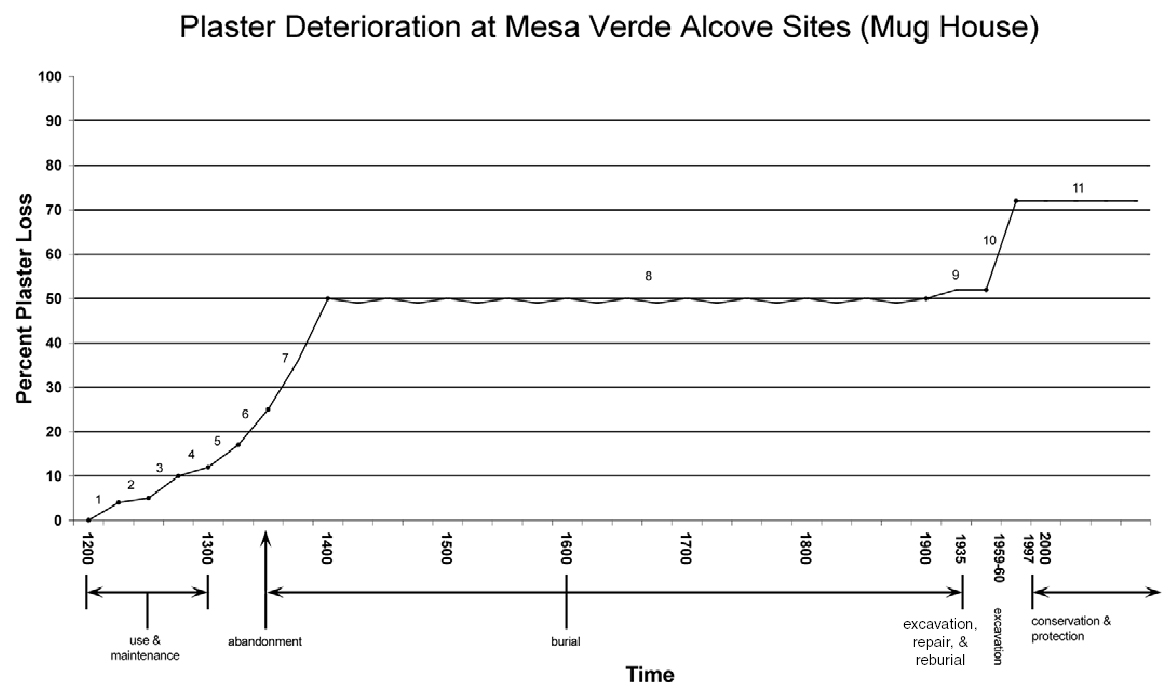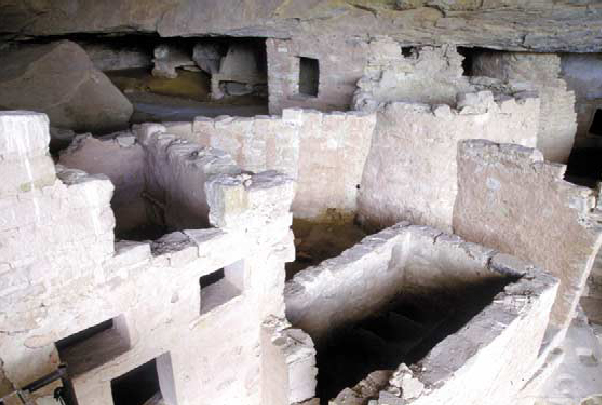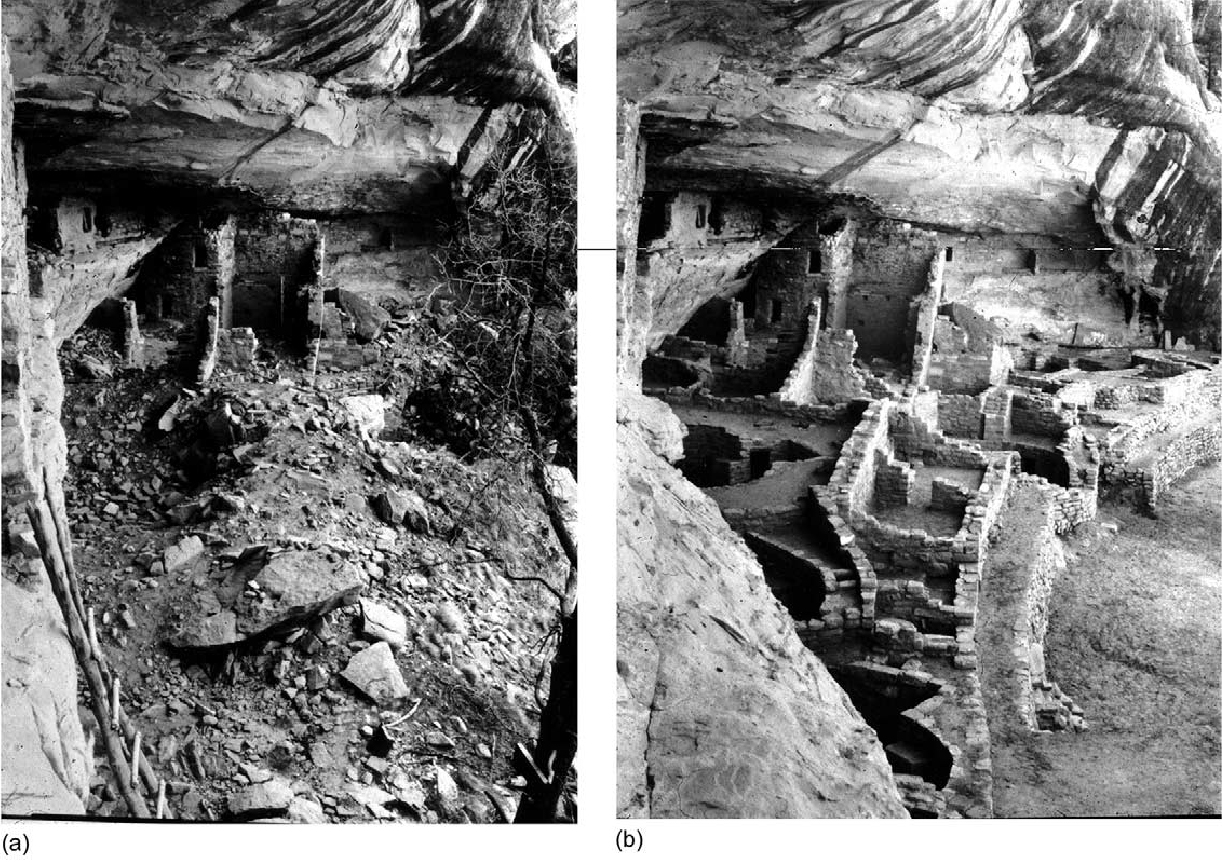MANAGING CHANGE: THE ROLE OF DOCUMENTATION AND CONDITION SURVEY AT MESA VERDE NATIONAL PARKFRANK G. MATERO
1 INTRODUCTION
Since its emergence in the early 20th century as a field of intellectual inquiry and applied practice, the conservation of historic and artistic works has matured into a distinct and professionally defined discipline. This development is owing, in part, to the adoption of an etiological approach to the examination and treatment of cultural property—that is, the relational study of the causes of deterioration and interventions based on scientific method. Other disciplines such as medicine and criminology share this methodology, whereby cause and effect (e.g., pathogen and symptom or motive and crime) are explored together in an attempt to offer explanation and thereby direct action accordingly. Establishing such relationships begins with observation and description, which in the case of conservation leads to documentation. Documentation and recording are the cornerstones of conservation practice.1 Conservators perform documentation based on the belief that by recording the tangible aspects of material Traditionally, documentation for conservation has long been associated with the physical state or condition of an object or site immediately before and after intervention (AIC 2001). No doubt this connection can be attributed to the physical changes most conservation treatments effect, as well as the contributions that documentation can make toward an increased understanding of the original appearance or technology of the object or site. But it has also been through the study of existing condition as a record of past change that conservators have seen the value of documentation and recording in developing a more accurate knowledge of alteration and deterioration. This relationship is especially the case for understanding long-term trends and patterns of decay, as well as the efficacy of treatment performance and durability predictions. By studying condition as the cumulative result of change over time through scientific observation and description, one can come closer to understanding alteration mechanisms and to identifying and managing deterioration as deleterious change. The road to accurate and effective diagnosis must therefore begin with a conscious methodology employing descriptive symptomatic recording, preferably executed over time. In this way, the variables of condition type, location, extent, and severity can be observed alone, together, and in combination with other factors such as material design, including construction and composition, environment, use and modification, maintenance, and previous conservation. As Hughlings Jackson cautioned years ago, “The study of the causes of things must be preceded by the study of things caused” (quoted in Beveridge 1957, 15). In recent years, the technology for producing more accurate and comprehensive documentation has increased dramatically through the development of newer imaging and computer graphic software programs, such as AutoCAD, and Geographic Information Systems (GIS), such as ArcView, and the creation and adaptation of nondestructive investigation and monitoring apparatus (Palumbo 2000). These tools have promoted the development of condition assessment surveys as critical diagnostic vehicles that go far beyond earlier interests in recording the immediate physical status before and after treatment. As powerful graphic methods, these digital aids allow the manipulation and analysis of large data sets and long-term recording, which ultimately should result in better conservation and management decisions. However the true value of any condition survey program must begin with a clear definition of what information is required and why. All recording is deceptively subjective, always performed with a specific objective or from a particular point of view. Contrary to modern scientistic notions, it is the moment at which interpretation begins. The documentation of structures and sites and associated building arts such as mosaics, sculpture, and wall painting presents enormous difficulties attributed as much to their size and complexity as to the pressures of utility and context. Existing buildings and sites do not come to us unchanged. A great many agents and phenomena, ancient and modern, transform sites over time and in different ways. A variety of natural and cultural processes, including natural decay mechanisms and human actions, continually alter a building's fabric and form. Daily maintenance, intermittent repair, use and reuse (including ritual activity), neglect, decay, abandonment, and recovery are among the diverse yet plausible processes that translate past actions and events into present conditions. As a result, the physical condition of any structure or site is a record of the interaction of many different determinants over the course of its existence (fig. 1). For most archaeological sites these determinants include (in general order of occurrence):
These determinants characterize individual Despite the inevitable alteration that entropy effects on all matter, such material transformations are not random but patterned, reflecting the predictable consequences of natural weathering cycles and decay mechanisms. These processes can be and were altered consciously and unconsciously by human action, thus making the reading of the resultant conditions over time a diagnostic challenge, yet one filled with the potential for understanding the complex and critical relationship between cause and effect, damage and treatment, past and present. In the end, it should be possible to establish a relationship between specific causative variables, specific decay mechanisms, and regular and predictable effects learned through detailed descriptive observation, monitoring, experimentation, and historical research. Fundamental, then, to the role of condition survey as a diagnostic tool is the concept of a site or building's life history and the interpretation of condition as “accumulated evidence” of natural and cultural events mapped onto the physical form and fabric. This concept requires a reverse reading of the site or building by first observing and describing—i.e., recording and then interpreting the effects of the alterations leading to an understanding of what, where, when, how, and why such changes occurred.
To borrow a much-used linguistic parallel, reading requires an understanding of word definition and grammatical construction, which determine and shape meaning. Meaning is a function of the original text and all the readings and interpretations of that text from the beginning. Similarly, with condition diagnostics, the process of understanding must begin with the construction of an understandable and reproducible language describing the evidence observed. In practice, many conservators underplay the subtle contributions that clear, descriptive conditions recording can bring to the causal interpretation and treatment of works. Once such a system is constructed, tested, and in place, the collection, management, and correlation of the data afforded by recent advances in digital technology can allow for sophisticated readings and flexible interpretations. This correlation can then be applied toward the development of a greater range of conservation treatment options and management strategies, including long-term monitoring and preventive conservation. All condition assessment surveys depend on qualitative and quantitative recording that describes the type, location (macro or micro), status (active or inactive), extent, and degree of severity for each condition observed. Wherever possible, this recording should be performed over time where photographic or other past descriptive information exists. The medium or format by which this recording is done depends on what is being described, the size and scale of the work, the degree of accuracy required, and the equipment, skill, and time available. The first step in recording any condition involves the use of a structured classification system and precise, exclusive language and graphics. Because many decay mechanisms can be caused by various and complicated scenarios involving intrinsic and extrinsic factors, and because similar symptoms may result from different causes or different symptoms from the same cause, simple descriptive terminology based on the clearly stated observation of discernible physical characteristics is always preferable during the initial survey process. In this way, observations can be recorded that are free from the causal implications often associated with many commonly used terms (e.g., spalling) and in a more useful manner before a fuller understanding of the problem can be gained through other subsequent or parallel investigative and analytical techniques. This process usually requires the creation of a defined and coherent terminology, often accompanied by photographic and schematic illustrations, and designated colors and graphic symbols for mapping conditions and materials. Classification schemes are usually designed to serve a specific end, be it in preparation for treatment or to monitor deterioration or intervention. They represent an artificial hierarchical typology of the variables observed that, when considered with other information, can be termed “pathography,” or the descriptive science of studying and recording physical conditions. Standardized nomenclature is a fundamental requirement for all scientific inquiry. Early on, Milton Bradley summed up the importance of standardization in his study of color and color systems, warning, “Where there are no standards there can be no measurements, and if … we have no measurements of effects, no records can be made, and hence no comparisons of results at various places and times, and consequently no discussion and little progress” (Bradley 1895, 5). Attempts to develop material conditions standards began with the creation of organizations such as the American Society for Testing and Materials (ASTM) in the early 20th century. However, such standards were developed for specific modern construction materials such as concrete, wood, steel, and paints and relied on simple definitions and photographic or graphic standards for the explication of type and severity of condition. The development of specific condition-recording standards for architectural conservation contexts occurred much later in response to individual need with the creation of institutionally based systems such as the recommendations of the standards committee for stone-based products (NORMAL) in Italy (1990) and the work 1.1 ARCHAEOLOGICAL SITES AND SURFACE FINISHESThe conservation of architectural remains at archaeological sites presents great difficulties in the development and implementation of resource management programs. Current practice in the conservation and interpretation of such sites attempts to maximize documentation and the retention of original material in situ while, at the same time, often requiring interpretation of the remains in a manner that is sensitive to their preservation as well as intelligible to the public. This aim poses a difficult problem for any structure in a fragmented state and especially for fragile elements such as painted plasters, which are best understood in their original context but also highly susceptible to deterioration and loss. Despite earlier practices of complete or selective removal of architectural plasters and finishes from ruins and archaeological sites, preservation and interpretation in situ are now ideologically the preferred solution, even if shelters or reburial are the only option. In situ conservation ensures the possibility of future studies of the whole resource and allows the opportunity to view the ruin as a once-complete structure. Surviving plasters with their finishes, in particular, contribute significantly to our understanding and appreciation of these architectural sites by providing additional information on aesthetics and technology, and possibly contributing to a greater understanding of architectural function, status, and meaning (fig. 2, see page 59). In addition, such surface finishes make tangible and human what otherwise might be incomprehensible to the visitor and scholar alike. 1.2 THE MESA VERDE PROJECTWith these issues in mind, the U.S. National Park Service and the Architectural Conservation Laboratory of the University of Pennsylvania began collaborating in 1994 to develop a model program for the study and treatment of the masonry and architectural surface finishes of the cliff dwellings of Mesa Verde National Park, a World Heritage Site in Colorado, in the southwestern region of the United States. The principal goals of the program have been to develop a comprehensive management system for the documentation and recording of these architectural components, to design and implement remedial and preventive conservation methods, and to integrate simple management practices into park maintenance so that further loss and damage of the prehistoric record can be prevented. Dubbed CASPAR—for Conservation of Architectural Surfaces Program for Archaeological Resources—this multiphased program has included a broad range of research and field activities, including architectural and condition documentation and recording, material analysis and characterization, condition survey, environmental monitoring, and treatment development, implementation, and evaluation. These activities have all been accomplished in the context of academic research and training. Despite the worldwide occurrence of earthen and masonry systems and their susceptibility to decay, no systematic program for their recordation or study as a discrete architectural component had been formalized (Matero 1999). One of the goals of CASPAR was to develop a comprehensive documentation and condition recording program whose objectives included:
Over the course of seven years, the masonry and plasters within ten rooms and five kivas at Mug House and, later, five rooms and exteriors and five kivas at Cliff Palace were recorded by graduate students using the developed system. Mug House on Wetherill Mesa was selected as the model test site due to its moderate size (90 rooms and 8 kivas), high percentage of original wall fabric, and excellent documentation both before and after excavation and stabilization in 1959–60 by Arthur Rohn (fig. 3). Kiva C was chosen as the representative unit to be fully documented, with an architectural database and a 53-sector digitized graphic condition survey, due to the significance, extent, and poor condition of its mural paintings (fig. 4, see page 59) and the opportunity to reassess a previous pilot treatment program executed in 1981 by Paul Schwartzbaum and Constance Silver (Silver 1982). This condition survey, taken together with a compilation of the site's history of archaeological excavation and stabilization, a geological assessment of the alcove, the characterization and analysis of the plasters and surface finishes of Kiva C and Room 28, and the environmental data obtained through a two-year monitoring program (1996–97 and 1998–99), affords a more complete diagnosis of decay mechanisms than has yet been attempted at these alcove sites.
|



